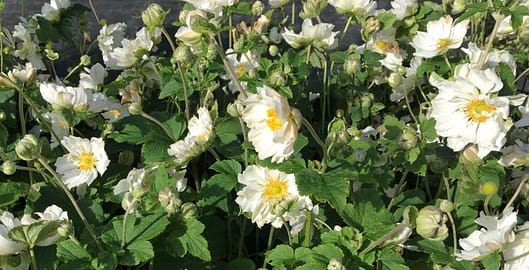At it’s best:
‘September Charm’ flowers in August and, as it’s name suggests, September, making it a top choice for our ‘plant of the month’. Its host of soft pink slightly cupped, yet saucer-shaped flowers are a deeper pink on the underside of it’s petals and are set-off splendidly by its yellow stamens. The flowers are held aloft on fine upright stems that are slightly taller than other varieties, allowing them to gently nod and dance in the wind (which may account for their common name of ‘Windflower’). Winner of an RHS Award of Merit for its many virtues in the garden, it also makes a great cutting flower for vases in the house.
When and where to plant:
Perfectly positioned in partial sun, though it will tolerate full sun so long as it’s kept well-watered, September Charm loves to be in rich, moist but free-draining soil. Whatever you do, don’t let it dry out. Prefers a sheltered position and will grow to 3-4ft tall with a spread of around 2-3ft. In the right location they will naturalise prolifically and can become a bit of a thug, albeit a very pretty one, however this low maintenance plant dislikes being moved around so once planted is best left alone. Mixes well with grasses and other perennials such as asters, it works wonderfully when planted in the borders of a cottage garden style or a naturalistic prairie or meadow planting scheme. Salt-tolerant, this versatile little gem will also look great in coastal gardens.

Tolerance and resistance:
Resistant to most insects and disease, plus it won’t be nibbled away by visiting deer or rabbits. This is a hardy perennial, though in colder parts of the country it may need mulching in the winter.
Wildlife:
Anenomes are attractive to both butterflies and bees, so are a good addition to any wildlife-friendly garden.
Curious cuttings:
Often described as Japanese, this type of anenome is actually a native of China, the confusion arises from its cultivation in Japan over many centuries. The plant was first introduced to Britain in 1844 by plant-hunter, Robert Fortune, after he found it growing in China, where it was traditionally used to commemorate family ancestors and offer protection from evil spirits.
If you’d see to know what we chose as our plant of the month for August 2017, simply click here.


